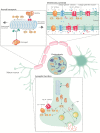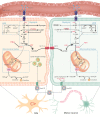Energy metabolism in ALS: an underappreciated opportunity?
- PMID: 29549424
- PMCID: PMC5978930
- DOI: 10.1007/s00401-018-1835-x
Energy metabolism in ALS: an underappreciated opportunity?
Abstract
Amyotrophic lateral sclerosis (ALS) is a relentlessly progressive and fatal neurodegenerative disorder that primarily affects motor neurons. Despite our increased understanding of the genetic factors contributing to ALS, no effective treatment is available. A growing body of evidence shows disturbances in energy metabolism in ALS. Moreover, the remarkable vulnerability of motor neurons to ATP depletion has become increasingly clear. Here, we review metabolic alterations present in ALS patients and models, discuss the selective vulnerability of motor neurons to energetic stress, and provide an overview of tested and emerging metabolic approaches to treat ALS. We believe that a further understanding of the metabolic biology of ALS can lead to the identification of novel therapeutic targets.
Keywords: Amyotrophic lateral sclerosis; Energy metabolism; Metabolic dysfunction; Metabolic treatment; Mitochondria; Neuron-glia metabolic coupling.
Conflict of interest statement
The authors declare no conflict of interest.
Figures



References
-
- Alavian KN, Dworetzky SI, Bonanni L, Zhang P, Sacchetti S, Mariggio MA, Onofrj M, Thomas A, Li H, Mangold JE, Signore AP, Demarco U, Demady DR, Nabili P, Lazrove E, Smith PJ, Gribkoff VK, Jonas EA. Effects of dexpramipexole on brain mitochondrial conductances and cellular bioenergetic efficiency. Brain Res. 2012;1446:1–11. doi: 10.1016/j.brainres.2012.01.046. - DOI - PMC - PubMed
-
- Allen SP, Rajan S, Duffy L, Mortiboys H, Higginbottom A, Grierson AJ, Shaw PJ. Superoxide dismutase 1 mutation in a cellular model of amyotrophic lateral sclerosis shifts energy generation from oxidative phosphorylation to glycolysis. Neurobiol Aging. 2014;35:1499–1509. doi: 10.1016/j.neurobiolaging.2013.11.025. - DOI - PubMed
Publication types
MeSH terms
LinkOut - more resources
Full Text Sources
Other Literature Sources
Medical
Miscellaneous

